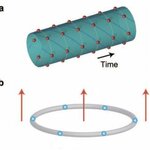Space

What to give the person who has everything? A clock that will keep perfect time even after the heat-death of the universe.
Such a "space-time crystal" has periodic structure in time as well as space. Why haven't we built those? With such a 4D crystal, scientists would have a new and more effective means by which to study how complex physical properties and behaviors emerge from the collective interactions of large numbers of individual particles, the so-called many-body problem of physics. A space-time crystal could also be used to study phenomena in the quantum world, such…

Sharpless 2-292, a stellar nursery called the Seagull Nebula because it seems to form the head of the seagull, glows brightly due to the energetic radiation from a very hot young star lurking at its heart. Now it has gotten a new look courtesy of the Wide Field Imager on the MPG/ESO 2.2-meter telescope at La Silla Observatory.
Nebulae, interstellar clouds of dust, molecules, hydrogen, helium and other ionized gases where new stars are being born, are among the most visually impressive objects in the night sky. Although they come in different shapes and colors, many share a common…

Gravitational lensing has found MACS1149-JD1, which was created less than 500 million years after the Big Bang, making it the most remote galaxy ever to be observed.
Our universe came into being approx. 13.7 billion years ago with a Big Bang. 400 to 500 million years later, conditions in the cosmos allowed for the formation of the first stars but it was believed there was almost no hope of ever receiving a signal from any object of this time period; if there already were galaxies back then, their brightness would be far weaker than the light of a candle on the moon.
The researchers say…

We are in a new space revolution, and in the past two years, several people have used the Kickstarter crowd-funding platform to try to get into space. Not all succeeded. Let's look at the current standings. They are, in order of kickstarter: Team Prometheus, Project Calliope, Sampling Space, KickSat, ArduSat, and most recently SkyCube.
A little history is in order. The progenitor of amateur space, of non-government non-corporations actually launching their own satellite to do whatever they personally want, is the OSCAR satellies by AMSAT. 40 years ago-- 40…

Neil Armstrong, the first man to walk on the moon, died last Saturday in Ohio at age 82 and his funeral service is tomorrow. Like most everything else about him, the service is private.
Yet the cosmos has decided to ignore the wishes of his family and so Armstrong is getting a special event for the occasion: a blue moon. Either that, or his family is being clever.
If you are not familiar with your old timey terms, "once in a blue moon" has come to signify 'not very often'. Since we get a full moon once every 29.5 days having a second full moon in a month is obviously infrequent, about…

A project that investigated the planetary radio-frequency emissions of the Earth and Saturn also discovered a strange radio emission from the planet Jupiter.
The Earth is loud. As in"radio-loud", which is how objects causing measurable radio emissions are described in astronomy. The Earth's magnet field influences charged particles (electrons, protons, and ions) in a way that causes radio emissions. Other planets such as Saturn or Jupiter cause these emissions as well and measuring them allows us to draw conclusions about planetary magnetic fields.
The new analysis discovered a new…

As a newly minted, 1 year old professor, this is the deep end of the astronomy edu
cation pool. I am swimming in the insights and experiences of people with more experience than me. I recommend attending an Astronomical Society of the Pacific meeting for this very reason. This is where you can find the answers to questions you hadn't yet realized were questions.
It will take a while for me to assimilate (and type; I am using a nook), but here are three tidbits.
If you give a planetarium show about supernovas providing the elements of life, and your visuals show supernovae, your audience will…

The Carnival of Cosmology: Bloggers on Dark Energy is now up and running on Matthew R. Francis' Galileo's Pendulum:
In the spirit of blog carnivals, several of us—cosmologists, physicists, astronomers, and writers who just love all these subjects—decided to write about one of the abiding mysteries of modern cosmology. That mystery is dark energy, the name we give to the accelerated expansion of the Universe.
There are contributions from Ethan Siegel, Kelly Oakes (of Basic Space) interviewed Nobel Laureate Brian Schmidt, one of the astronomers who discovered dark energy, astronomy writer…

The Curiosity rover has landed safely on MARS, we have seen the image of the wheel on the surface. There were good reasons to doubt the "Sky crane" approach to a landing. Just one computer glitch, just one wrong calculation, just one strange interaction of various systems and the story would be different.
The difficulty of this has been compared in recent days to "sticking the dismount" in gymnastics. This is that times a million. It's like making a robot that can do the routine and land on it's feet, based only on its AI, while falling from space! It was…

NGC 1187, a spiral galaxy about 60 million light-years away in the constellation of Eridanus (The River), may look tranquil but it's home to some violent events. NGC 1187 has hosted two supernova explosions during the last thirty years, the latest one in 2007.
NGC 1187 was discovered in England by William Herschel in 1784 and can be seen almost face-on, which gives astronomers a good view of its spiral structure. About half a dozen prominent spiral arms can be seen, each containing large amounts of gas and dust. The bluish features in the spiral arms indicate the presence of young…